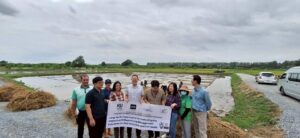
Sustained price volatility” was the conclusion at the 7th World Rice Commerce 2008 Conference held in Chiang Mai, Thailand, on 20-22 October.
Addressing business concerns facing the rice industry, the event brought together representatives from export giants Thailand, Vietnam, India, Pakistan, and the United States, who joined key market participants (including the National Food Authority of the Philippines and Perum Bulog of Indonesia) and a panel of experts representing the world’s most prominent traders. Participants analyzed the skyrocketing market prices witnessed up to May 2008 and the slide down since, and tried to glimpse the future.
Stability was key as participants recognized sustainable supply, growing demand, and a stable price as the foundations necessary to build a rice industry that can ably overcome food security concerns and offer an affordable staple for some of the world’s poorest people. However, current record crops in Southeast Asia, India, and China conspired with a seemingly elastic demand (that is, demand decreases as price increases) to lower prices and raise concerns about long-term stability of supply. In short, if prices continue to bounce around as they have for the past year or so, future plantings are likely to expand and contract accordingly.
Commenting on the events leading up to the May highs in food price and the downward trend since, Apiradi Tandtraporn, director general, Department of Foreign Trade at Thailand’s Ministry of Commerce, described the situation as a wakeup call. “It is the cumulative effect of long-term trends in supply and demand and not any sudden effect,” she said.
In an environment of falling prices, keynote speaker Ms. Apiradi voiced her fears for food security as falling prices threatened to curb future plantings. She revealed the pressures facing policymakers (managing Thailand’s rice retention program, for example) in achieving consistent supply and availability of rice, as well as a genuine commitment to develop Thailand as the “rice bowl to the world.”
“Rice is produced by poor countries and consumed by poor people; let’s help solve the dilemma,” said Ms. Apiradi, emphasizing the need for stability and a price that also takes into account farmers’ living conditions.
Food security and maintaining production
Mulyo Siddik of the East Asia Emergency Rice Reserve highlighted the challenges in maintaining production (such as its susceptibility to weather and other uncontrollable factors), with production failure resulting in consequences reaching beyond food security to national security. A longterm strategy was seen as vital in supporting price stabilization, encouraging production, and enhancing yield. Dr. Mulyo said that this must be combined with long-term reserves to prevent unnecessary price volatility and consequent production responses.
Reluctance from buyers expecting even lower prices unveiled a major flaw in the balance between the needs at destination (demand) markets and at origins (exporters). This imbalance threatens to disrupt supply and add to the already daunting long-term challenge facing policymakers and research organizations in delivering sufficient rice to the world.









